| | | | |
|
The

Gainclone Gallery
Gainclone Gallery page 4.
Click on the pictures for a full-size version.
|
|
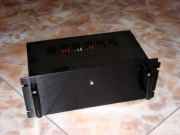
|
Digi01 from China has produced this professional looking example using the LM3875 chip and 2200uF decoupling capcitors. Digi01 has provided full details of this amp on his site
|
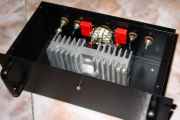
|
The inside of Digi01's Gainclone is very neat and features a 6 position stepped attenuator. The internal heatsink will minimise the possiblility of transferring airborne vibrations to the chips.
|
|
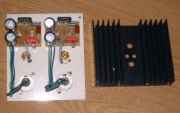
|
Living in the Cayman Islands means that it is difficult for Andrew Brandon to obtain parts so he decided to order a kit from Scott Nixon. Andrew describes the mods he made to the original kit.
|
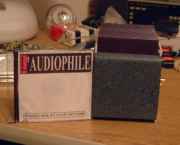
|
I used the "Ampkit", changing 3 components: a BG 4.7uF input cap, Riken 10K input R and an "old" 220K Holco FB R. I enlarged the holes for the PSU wires on the pcb to accomodate a slightly larger gauge wire and moved the FB resistor from the component side, where it is placed beneath the LM3875 legs, to the foil side for easy changes.
|
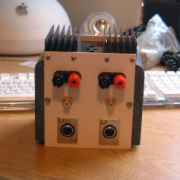
|
The case is recycled stuff, front and rear were aluminium blanking plates from a computer rack while the sides are Corian cutoffs. The heatsink I got out of the garbage from the communicatons company next door. My inspiration was the Apple Cube computer. I wanted to build a small case to keep with the theme of the small amplifier. I call it the "Gaincube"
|
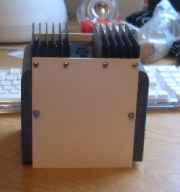
|
The p/s is dual mono using Avel Lindberg Y236503 toroids,
and UG10DCT diodes and the case is from an old computer monitor switchbox.
I plan at some time in the future to change the p/s box for something proper, we'll see how that develops.
|
|
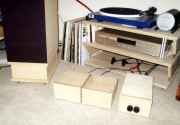
|
Apart from building some kit 'speakers, the Gainclone was Piero Serra's first attempt at building hi-fi. Choosing the simplest inverted circuit, Piero patiently persevered and was rewarded with some excellent results.
|
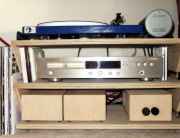
|
Like many before him, Piero decided on a simple wooden box to house his Gainclone and the results are very pleasing and match the rest of his system.
|
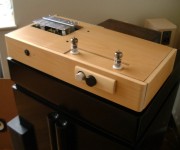
|
After five years of good service, Piero decided it was time to reward his VBIGC with a bit of TLC. The case was rebuilt using Brazilian pine, wit hthe valves having their own plinth.
|
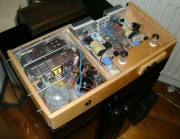
|
Inside, the wiring got tided up a bit and the Velleman loudspeaker module was replaced with a new one.
|
|
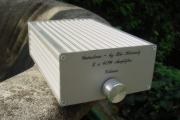
|
Elio Kleinertz opted for the this popular extruded aluminium housing and customised it with some neat sign writing.
|
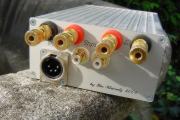
|
The rear view shows a very neat and methodical layout. Inside are LM3875 chips.
|
|
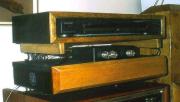
|
Ron Clarke is renowned for his battery operated Gainclones but used a swicthced-mode PSU for this creation. The PSU is in the
|
lowest box with the actual GC sitting above it. Ron's GC is an inverted LM3875 design with twin (shunted) Alps volume controls.
|
The voltage rails are +/-24 volts with 1000 uF on each pin. Ron has used a 330K feedback resistor with a 22K input.
|
|
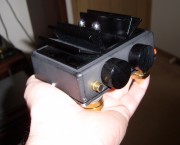
|
Mark Houston's intention was to build a very small palm size GC around the 3875. Of course it would have to be with remote PS. But he wanted the amp section to sit-up by itself, look very small if not cute and deliver “big time”. He used a die-cast thick aluminum case which measures 119 X 94 X 34 mm. two attenuators, and 4 X 5600 uf 40V quality electrolytics to construct the amp.
|
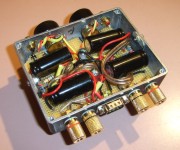
|
Metal film resistors and pure silver wire and was used for the input sig. path and heavy copper wire for the output.
The remote PS employed a 160VA toroidal, rec. bridge and 4.7 uf polyprops. An internal EMI 240V filter provides clean power to the PS. The +/-30 Volt umbilical cord is choked at entrance to the amp. Heavy duty isolation feet and 12 mm glass isolation plate on silicon provide a sound base for the amp.
|
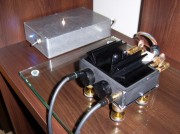
|
Mark says: "Play it loud with jazz trios or back-it-off with rock and the temp stays under control. Wind it up too far for too long and SPiKe will get you. Great sound but my 3875 mono-blocks eat it for sound stage."
|
|
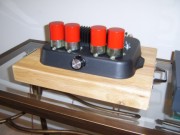
|
Another GC from Mark Houston. Concept: The Synergy amplifier is based on a “mass-loading” principle where the chassis is very heavily and rigid and the active components, in this case and minimalist chip amps, almost become a minor consideration. The idea is to reduce cct. resonance by loading the active components with heavy and dense dissimilar materials. In this case a 3mm thick die-cast aluminum Teflon coated baking pan to act as the chassis and a 60mm thick laminated timber chopping board. The two are torqued together with 6mm thick steel bolts, spring washers and wing nuts. You need the handles it weighs 26lb!
|
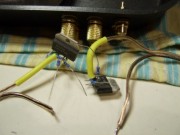
|
Minimalist Chip Amp: Using no cct. brd, just wire the three resistors direct onto the pins of the chip-LM3875. The chips (bolted under the large heat sink add to increase chassis mass) now form part of the chassis and work in Synergy with the rest of the amp. The 10,000uf 100V red caps are paralleled with 10uf polypropylenes and .1uf polyesters to form the line caps.
|
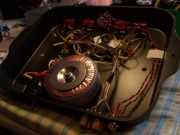
|
The Power Supply and Internal Wiring: A 160VA toroidal tranni and rectifier bridge (snubbed with .1uf) are used to supply +/-38V DC to the chips. The mains power is provided through a RFI filter built into the chassis. The mains earth is supplied via an 8.2ohm 5W resistor whose earth lead is looped through a ferrite tube to reduce hum and RFI. Oxygen free 1.2mm copper wire (OFC) feeds the power from the rec. bridge to the power caps and from the caps to the chips. Pure silver (0.7mm) wire connects from the input gold plated RCAs to the attenuator and to the chips.
|
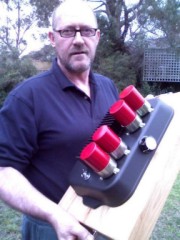
|
Extra heavy copper speaker cable connects from the chips output to the speaker binding posts. A star earth is the only earth.
MASSive Sound from MASS-loading: You read where the subjective reviewer tells of the equipment vanishing revealing the music unfettered. This is the first time I have experienced this. There are no speakers there is just the music. A soundstage projecting from the wall behind and from the sides fills the room.
|
Site menu
Page menu
Gallery page 1.
Gallery page 2.
Gallery page 3.
Gallery page 5.
Gallery page 6.
|
|
|




















